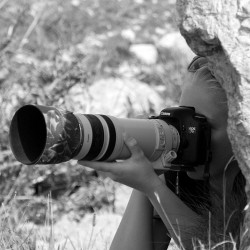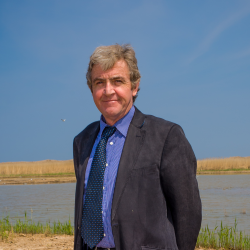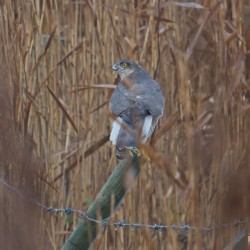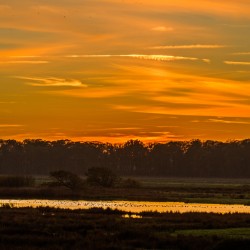North Norfolk: A Haven for Birdwatchers
When you think of North Norfolk, what probably springs to mind is its rugged coastline, picturesque beaches and unspoilt countryside. With numerous nature reserves, it’s a great place for birdwatchers, wildlife enthusiasts, walkers and photographers alike.
Amateur photographer and keen birdwatcher, Lauren Tucker, first became interested in photography because of a particular bird in her local area.
“I’ve always been into walking, but about 5 years ago we started seeing the resident buzzard frequently when we were out walking. I borrowed my sister’s camera and started taking a few snaps. We’ve seen the buzzard on 95% of our walks and I still haven’t got a shot of him that I’m pleased with, but it’s definitely safe to say the buzzard got me into photography.
“I mainly focus on wildlife photography as I enjoy being outside and there are always new species to capture and learn about. I also do a few landscape shots while out walking around local landmarks.”
Visiting North Norfolk
Lauren first visited North Norfolk back in November 2014, when she went on a birdwatching camping holiday with her father.
“It was just me and my dad on our trip, as we are the only photographers and birdwatchers in our family. We always enjoy ourselves and get to spend some quality time together.
“During our stay, we got up at sunrise and stayed out all day travelling around the different reserves to make sure we fitted everything in. We had limited time and didn’t want to miss anything. There were plenty of birding places to visit and none of these disappointed us!
“We enjoyed Cley Marshes the most as the Marsh Harriers put on a great show while we were there, and we also saw our first Grey Seal on the beach, along with some Snow Buntings. We managed to see a few new species while we visited. We also enjoyed Snettisham for the early morning bird displays, but unfortunately the day we chose there was very heavy fog, so we will have to return to watch this. Watching the sunset from Holkham House was amazing as we got to see the Pink-Footed Geese return.”
Cley Marshes
Cley Marshes is the Norfolk Wildlife Trust’s oldest and best-known nature reserve. The blueprint for this site is being used across the country for other nature reserves, and they’re one of the top bird breeding sanctuaries around.
Chief Executive of Norfolk Wildlife Trust, Brendan Joyce said:
“Cley Marshes is where the Wildlife Trusts movement began in 1926, when a group of twelve friends led by Dr Sydney Long had a vision of a county trust to purchase and protect this precious site and others like it.
“At Cley Marshes, extending the scrapes where waders love to feed, and attending to the reed cutting and marsh grazing has meant birds that were feared lost to Britain as breeding species 90 years ago have come back to the marshes. Bitterns, marsh harriers, godwits and avocets have all returned to Cley.
“Norfolk Wildlife Trust now manages over 50 nature reserves and other protected sites around Norfolk including ten kilometres of coastline, nine broads, nine National Nature Reserves and five ancient woodlands.
“We seek a sustainable environment for people and wildlife: where the future of wildlife is protected and enhanced through sympathetic management; and people are connected with and inspired by Norfolk’s wildlife and wild spaces.”
A Variety of Terrains
There are a huge variety of landscapes to visit, which Lauren enjoyed exploring.
“The reserve has shingle beach, marshland, reed beds, lakes and small rivers, so it welcomes lots of different species. We saw the most variety on the marshland of the reserve – Marsh Harrier, Kingfisher and Skua. On the shingle we saw Snow Buntings, which was a first for us. They were so well camouflaged that they were hard to photograph, but great to see nonetheless!
Visitors Centre
In 2007 a new, eco-friendly visitor centre was opened with improved facilities, including a café, shop and a view point overlooking the marshes.
Lauren said, “We used the viewing areas on the reserve and in the shop, which had a beautiful view across the marshes towards the sea. We also went in every hide and saw at least 5 species in each!”
Brendan added: “The Cley Marshes Visitor Centre has proved tremendously successful for Norfolk Wildlife Trust, so much so that we needed extra space on site for wildlife education and to tell the story of the evolving landscape and its wildlife.”
For this purpose the Simon Aspinall Wildlife Education Centre was built. This multi-purpose building has regular presentations on wildlife and nature from a range of experts and authors.
“Dedicated to the memory of ornithologist Simon Aspinall, our education centre marks the start of a new chapter in almost 90 years of the Trust’s history as it brings a brand new programme of cultural and educational events and activities to Cley, which we hope our members, the local community and people new to the wonders of wildlife will enjoy.”
Adult learning workshops run throughout the year, including the ever popular Marsh Harriers talk. There are also frequent exhibitions of work from local artists and guided walks around the marshes – but be warned, they book up quickly!
For the kids, there are plenty of family events which give them the chance to learn more about local wildlife whilst getting their hands dirty. You can easily spend an entire day between the centres, café and exploring the marshes, so they’ll never get bored.
Lauren had nothing but praise for the workshop leaders and staff she encountered.
“We were talking to a few members of staff who worked for the reserve and they were all very friendly and knowledgeable, giving us the best places to go around the reserve. They were the ones who tipped us off about visiting the shingle beach for Snow Buntings.”
Advice for Others
Lauren recommends researching an area before you visit to pinpoint the best bird spotting areas.
“When going for local walks we decide where to go on the day, but when we travel to new places like Norfolk we always plan weeks in advance to ensure we’ve covered everything – including where to stay and where the best birding hotspots are.
“We spent over a month researching places to visit in Norfolk, and checked local sightings daily; this helped us pick the right places to go at that time of year. If it’s an RSPB site, we mostly research online to look into the reserves, but we also use local bird sighting blogs, Flickr, social media and ask our local birdwatching buddies to get advice if they have visited before.”
She also had some advice for other people hoping to work in photography.
“Photography is one of the hardest businesses to get into as everyone has a camera now, but if it’s something you enjoy doing, you never know where it will take you!
“I studied A-Level Photography back in 2010, but this course was focused more on composition. When it comes to aperture and shutter speeds on the camera I am self-taught and pick up tips and tricks as I go along. I’d recommend really getting to know your camera and experiment with effects and angles.
“I hope to have photography as a full-time career at some point, but at the moment I enjoy it most being a hobby. I love travelling the country and going walking with my dad who shares the same passion as me for wildlife and photography.”
Visit North Norfolk Now
Lauren managed to get some great shots on her visit and really enjoyed the North Norfolk countryside.
“We would definitely recommend Norfolk as a holiday destination. Whether you’re a birdwatcher or a walker, it’s a stunning part of our country. We really enjoyed each and every place we visited and can’t wait to return soon!”









